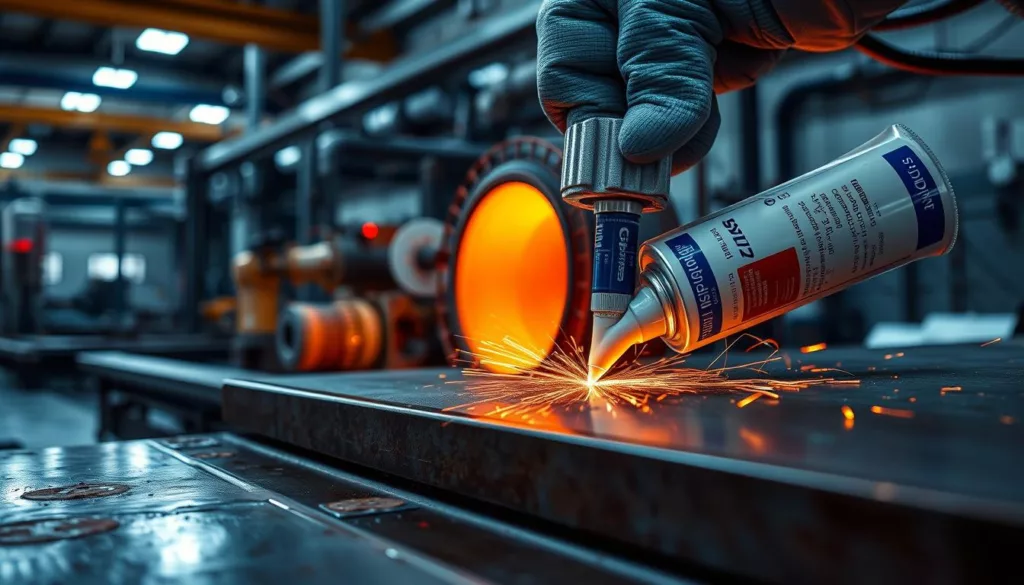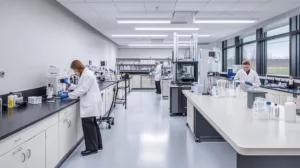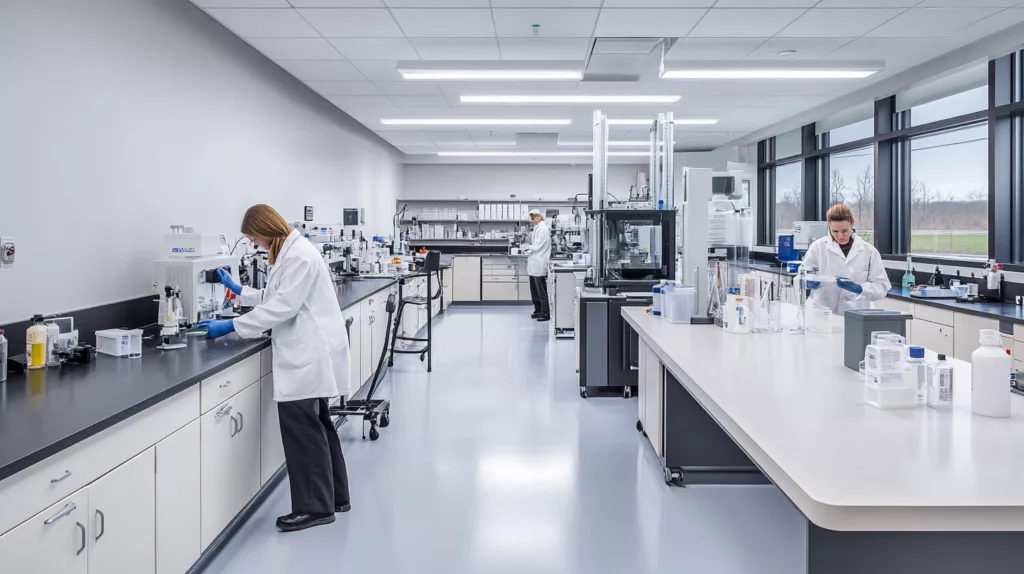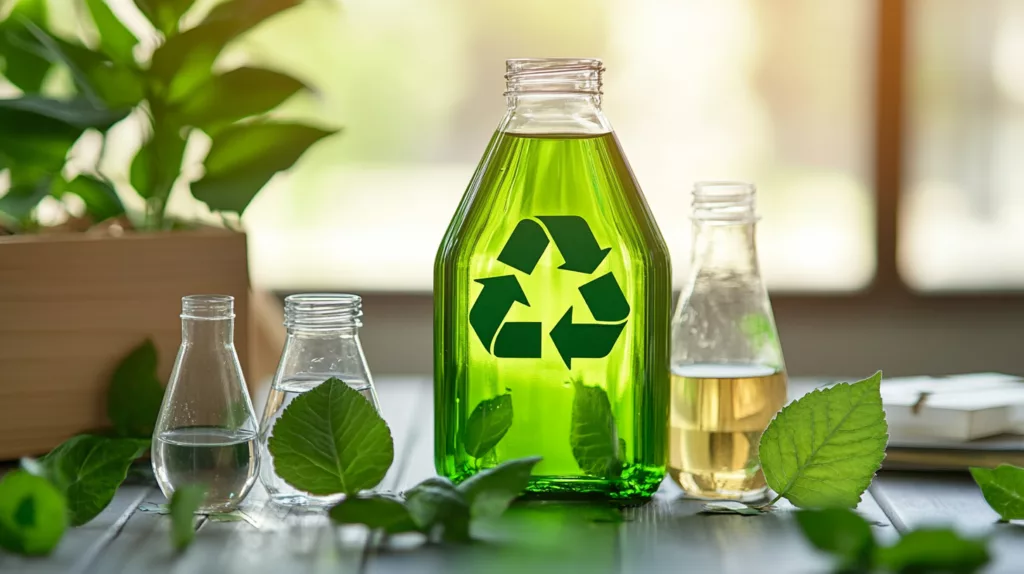In today’s fast-paced world, finding a good adhesive for industrial use is key. These adhesives stick well, even in harsh conditions like high heat and moisture. At ZDS™, we make top-notch heat-resistant glue for both pros and DIY fans.
We focus on making our adhesives work great and last long. This helps keep your products strong and reliable.
Key Takeaways
- High-temperature resistant adhesives are vital for demanding manufacturing applications.
- These industrial adhesives are engineered to withstand extreme conditions.
- ZDS™ offers a range of specialized adhesives designed for various industries.
- Heat-resistant glue ensures the longevity and durability of bonded materials.
- Investing in quality adhesives can enhance overall production efficiency.
Introduction to High-Temperature Resistant Adhesives
High-temperature resistant adhesives are key in many industrial settings. They help manage temperature well. These adhesives stick strong in tough places, showing their value in many fields.
Definition and Importance
A high-temperature bonding agent can handle very high temperatures, over 300°F (150°C). It’s vital in areas needing top performance and trustworthiness in harsh conditions. Using this agent keeps parts strong and working well.
Key Characteristics
High-temperature resistant adhesives have special traits:
- They can handle extreme heat without losing strength.
- They stick well to many materials, like metals and plastics.
- They protect bonds from moisture and harsh chemicals.
These qualities ensure bonds stay strong in tough situations. This makes these adhesives essential for solid industrial bonds.
Common Applications
Durable industrial adhesives are used in many ways across industries, including:
- In aerospace, where accuracy and dependability are critical.
- In car assembly, to keep parts steady through temperature changes and stress.
- In electronics, for secure connections that resist heat and expansion.
Knowing these uses helps pick the best high-temperature bonding agent for each job.
Types of High-Temperature Resistant Adhesives
High-temperature resistant adhesives are key in many industries. They are needed where things get very hot. We’ll look at three main types that work well in tough situations.
Epoxy Resins
Epoxy resins are known for their strong bond and heat tolerance. They are used as a specialized industrial adhesive. They can handle temperatures up to 400°F (204°C). This makes them great for the car and plane industries, where things need to last a long time.
Silicone-Based Adhesives
Silicone-based adhesives are flexible and can handle high temperatures. They work from -60°F to 500°F. This makes them perfect for places that need to resist moisture. They’re also used in making appliances and other items that face extreme temperatures.
Polyimide Adhesives
Polyimide adhesives are top-notch for heat resistance. They can handle temperatures over 500°F (260°C). They’re often used in making electronics. This is because they provide strong bonds even in very hot conditions, making things last longer.
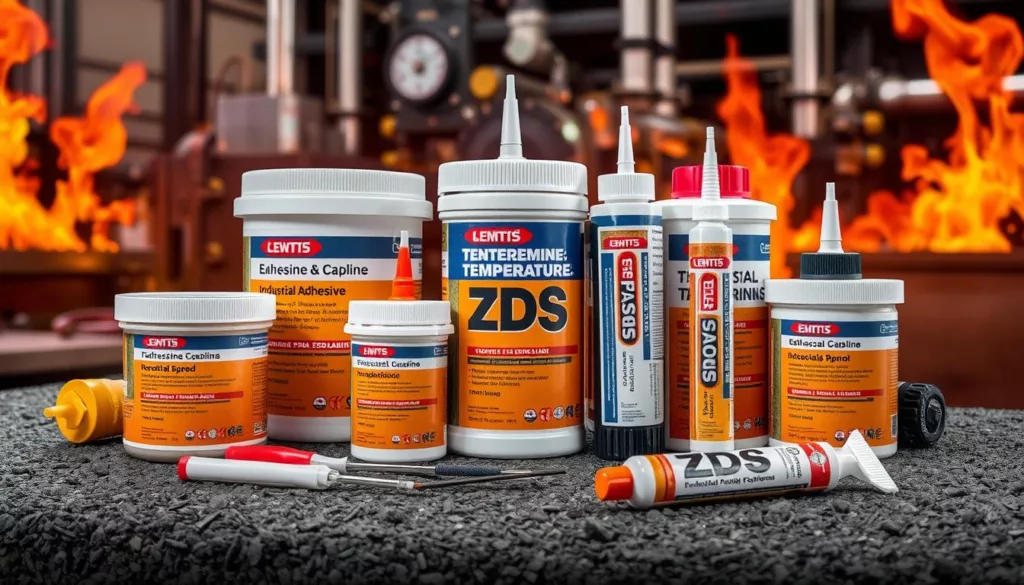
| Type of Adhesive | Temperature Range | Common Applications |
|---|---|---|
| Epoxy Resins | Up to 400°F (204°C) | Automotive, Aerospace |
| Silicone-Based Adhesives | -60°F to 500°F | Appliance Assembly, Moisture-Resistant Applications |
| Polyimide Adhesives | Exceeding 500°F (260°C) | Electronics Manufacturing |
Applications in Various Industries
Reliable high-temperature adhesives are key in many industries. They improve product performance and extend its life. Each field uses these adhesives for safety, efficiency, and effectiveness.
Aerospace and Aviation
In aerospace, these adhesives are vital. They help parts withstand stress and extreme conditions. They are used for:
- Composite bonding
- Structural assemblies
- Engine components
Automotive Manufacturing
Car making also depends on these adhesives. They ensure parts like:
- Exhaust systems
- Brake components
- Engine parts
are strong and safe.
Electronics and Appliance Assembly
In electronics, these adhesives are key for circuit boards and parts. They’re also important in kitchen appliances. They’re used for:
- Solder mask application
- Heat and moisture resistant bonding in appliances
Benefits of Using High-Temperature Resistant Adhesives
High-temperature resistant adhesives bring many benefits for different industrial uses. They make operations more efficient and products more reliable.
Enhanced Durability
A durable industrial adhesive creates a strong bond that lasts in tough conditions. It helps products last longer, cutting down on maintenance and replacement costs.
Temperature Tolerance
High-temperature bonding agents keep their stickiness even when it’s very hot. This is key for industries where parts face a lot of heat. It ensures products work well without breaking down.
Cost-Effectiveness
Choosing high-temperature resistant adhesives saves money over time. They help lower failure rates and reduce the need for repairs. This makes them a smart choice for companies looking to save.
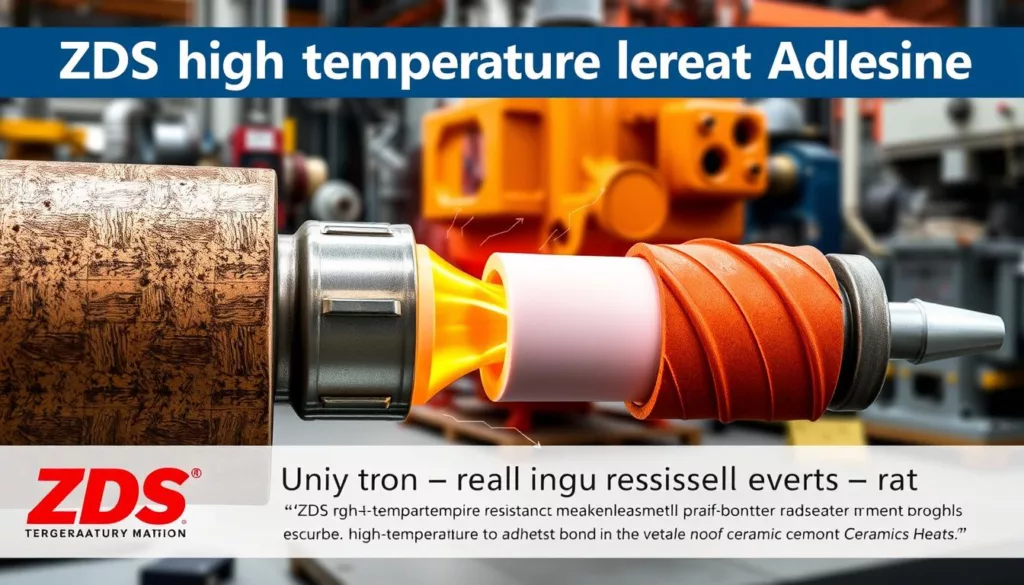
Selecting the Right Adhesive
Choosing the right high-temperature resistant adhesive is key for top performance in tough conditions. You need to think about several things to make sure it works well.
Factors to Consider
When picking an industrial adhesive, keep these points in mind:
- Application Temperature Range: The adhesive must handle the extreme temperatures of your application.
- Substrate Materials: Different materials need different adhesives for the best bond.
- Environmental Conditions: Things like humidity, chemicals, and stress affect how well the adhesive works.
Understanding Material Compatibility
It’s important to check if the adhesive works well with the materials you’re using. Using the wrong materials can hurt the bond. A high-temperature adhesive made for your materials can make the bond last longer.
Performance Testing
It’s important to test the adhesive and the parts it’s attached to thoroughly. These tests make sure the adhesive meets your needs and sticks well under real use. This careful approach helps make sure your product is reliable.
| Factor | Consideration |
|---|---|
| Temperature Range | Must exceed the application requirements |
| Material Type | Specific adhesives may be necessary for diverse materials |
| Environmental Conditions | Assess factors like moisture, chemicals, and mechanical stress |
Comparison of Adhesive Types
Knowing the differences between adhesives is key to a successful application. We look at important factors like strength, how they handle heat, and how long they take to dry. These aspects help choose the right heat-resistant glue, flexible high-temperature adhesives, and other industrial bonding solutions.
Strength and Bonding Capabilities
Adhesives vary in strength and bonding power, even when exposed to heat and stress. Epoxy resins are top-notch for heavy-duty tasks because of their high shear strength. On the other hand, silicone adhesives are flexible and can stretch without breaking the bond.
Temperature Performance
Adhesives have different heat tolerance levels. It’s important to pick one that can handle the temperatures your application needs. For example, polyimide adhesives are great for extreme heat, while silicone-based ones work well with moderate temperature changes.
Cure Time and Handling
The time it takes for an adhesive to dry is critical for production speed. Knowing how to handle different adhesives can make your workflow smoother. Fast-drying adhesives save time, while slower ones might offer stronger bonds, which is good for tasks that need more time.
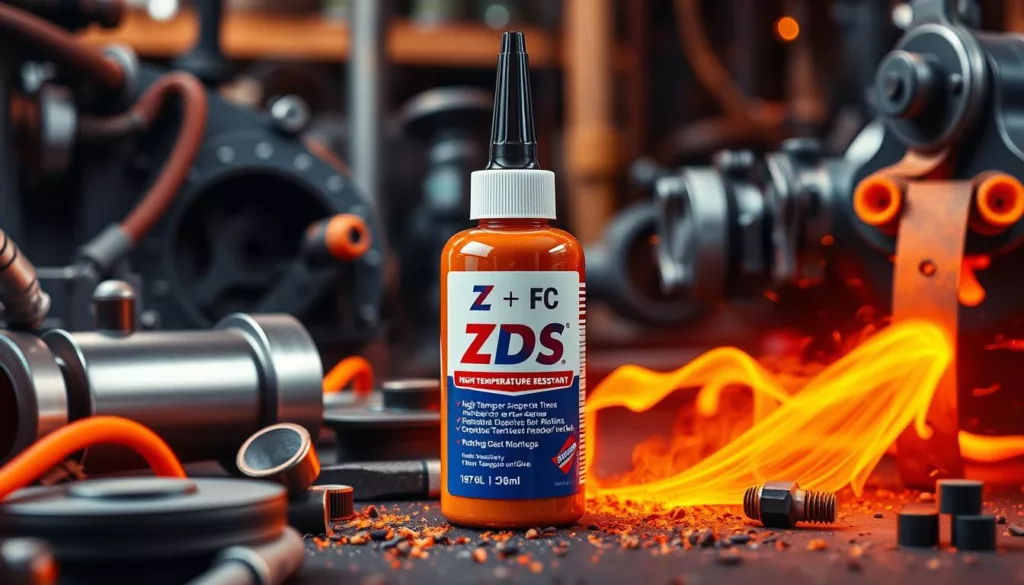
| Adhesive Type | Strength | Temperature Tolerance | Cure Time |
|---|---|---|---|
| Epoxy Resins | High Shear Strength | Up to 300°C | 8-24 hours |
| Silicone Adhesives | Moderate Strength | Up to 250°C | 1-4 hours |
| Polyimide Adhesives | Exceptional Strength | Up to 400°C | 1-12 hours |
Regulatory Standards and Compliance
In industries that need strict rules, picking the right adhesive is key. Sectors like food, automotive, and aerospace have their own rules. These rules help keep things safe and working well.
FDA Regulations for Food Industry
Adhesives in food handling and packaging must follow FDA rules. These rules make sure the materials are safe for indirect food contact. High-temperature adhesives help seal equipment and packaging safely, keeping food safe.
Automotive Industry Standards
The car industry has tough rules for adhesives to keep vehicles safe and running well. Adhesives are tested under harsh conditions to meet these standards. Following these rules makes car parts reliable and long-lasting, important for everyone.
Aerospace Material Specifications
The aerospace world has very high standards because of safety risks in flying. Adhesives must pass tough tests for durability, heat resistance, and reliability in harsh conditions. This makes sure materials work great in extreme situations, keeping everyone safe.
Best Practices for Application
Using a reliable high-temperature adhesive well needs some key steps. You must prepare the surface right, mix the adhesive correctly, and cure it properly. These steps help the adhesive work best, even in very hot or cold temperatures.
Surface Preparation Techniques
Getting the surface ready is key for strong bonds. This means:
- Cleaning: Get rid of dust, oil, or grease.
- Roughening: Make the surface rougher for better sticking.
- Priming: Use a primer if needed to help the adhesive stick better.
If you don’t prepare the surface well, the bond might not hold up.
Mixing and Application Methods
To get the best results, follow the maker’s advice on mixing and applying. Important things to remember are:
- Measure the parts accurately for the right mix.
- Mix well to avoid particles that can weaken the bond.
- Use the right tools, like brushes or rollers, to spread the adhesive evenly.
Sticking to these tips keeps the adhesive strong and reliable.
Curing Process Optimization
To get the strongest bond, you need to cure the adhesive right. Think about these things:
- Temperature: Keep the curing temperature as recommended.
- Humidity: Keep moisture levels in check to avoid problems.
- Duration: Give the adhesive enough time to cure fully, as the product says.
Getting the curing conditions right is very important for a strong bond, even in extreme temperatures.
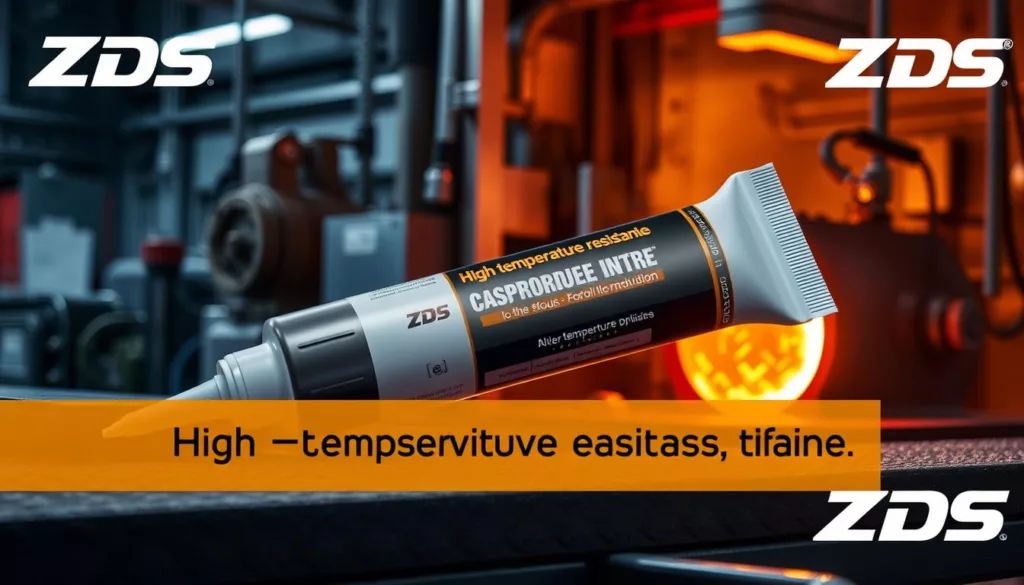
Storage and Shelf Life
Storing a high-temperature resistant adhesive right is key to its lasting power. Knowing how to keep it in top shape means it works best when you need it. Important things include the right storage, signs of wear, and how long it lasts.
Ideal Storage Conditions
Keep the adhesive cool and dry, away from sunlight and extreme heat. This keeps it working well for longer.
Signs of Degradation
It’s important to check on your adhesives often. Watch for:
- Viscosity changes
- Separation of parts
- Unusual color changes
These signs mean the adhesive might not work as well.
Recommended Shelf Life
Most high-temperature resistant adhesives last one to two years. Each type has its own shelf life. Following these times ensures it works when you need it in industrial settings. For more on choosing good adhesives, check out this resource.
| Adhesive Type | Recommended Shelf Life | Ideal Storage Temperature |
|---|---|---|
| Epoxy Resins | 1-2 years | 60-80°F |
| Silicone-Based Adhesives | 1-2 years | 50-80°F |
| Polyimide Adhesives | 1-2 years | 60-85°F |
Troubleshooting Common Issues
Working with high-temperature bonding agents can sometimes be tricky. Knowing common problems helps fix them quickly. This ensures the adhesives work as they should. Here are some common issues and how to solve them.
Bond Failures
Bond failures happen for many reasons. Some main causes are:
- Inadequate surface preparation
- Improper mixing ratios
- Environmental conditions such as humidity and temperature fluctuations
By tackling these problems, we can make high-temperature bonding agents work better. This leads to better results in adhesive applications.
Application Challenges
Challenges can pop up during the adhesive process. These include:
- Bubble formation
- Uneven application of the adhesive
- Difficulty in achieving strong adhesion
Using the right tools and techniques can help solve these issues. This makes the adhesive application smoother.
Environmental Factors
Environmental factors greatly affect how adhesives perform. Key issues to watch out for are:
- Exposure to moisture and chemicals
- Extreme temperatures
Checking the environment where adhesives are used helps avoid problems. Knowing how these factors impact adhesives helps manage their performance better.
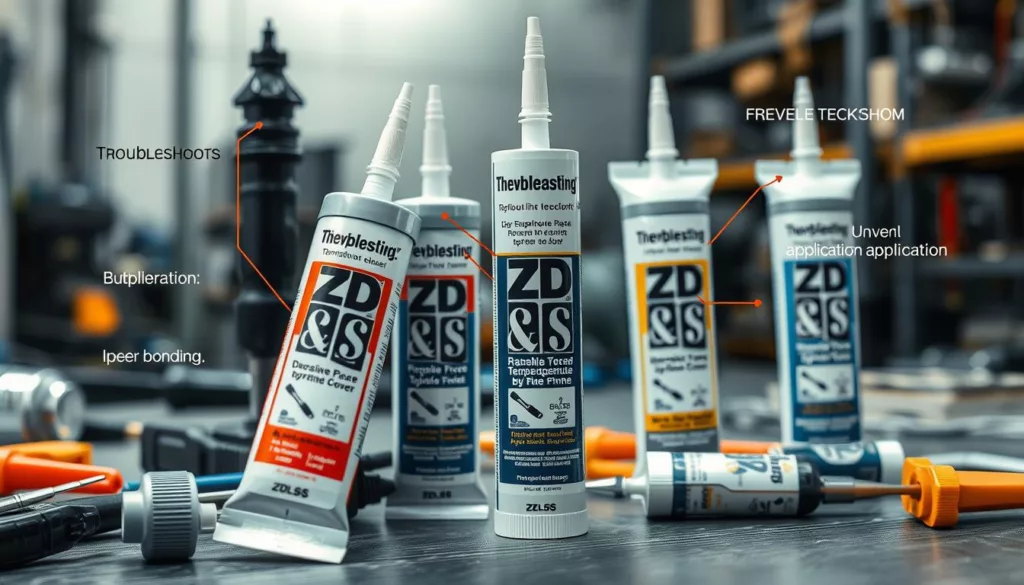
Innovations in Adhesive Technology
The world of adhesive technology is always changing. New breakthroughs improve how adhesives work and where they can be used. Companies now use special adhesives to meet tough demands.
Advances in Formulation
Scientists are working hard to make adhesives stronger and more heat-resistant. These changes help adhesives work better in tough places. This is good for the car and plane industries.
Companies are using new tech to make better products. This means we get more reliable solutions for our needs.
Impact of Nanotechnology
Nanotechnology is making big changes in adhesives. It makes them stronger, more heat-resistant, and cure faster. These improvements make manufacturing better and products more reliable.
Thanks to nanotechnology, companies can make adhesives for specific challenges. This shows how the industry is adapting to new needs.
Future Trends in Industrial Adhesives
The future of adhesives will focus on being green and smart. We’ll see adhesives that change with the environment and use eco-friendly materials. They will also get better at handling high temperatures.
This shows how adhesives will keep up with changing market needs. It’s exciting to see what’s coming next.
As the industry moves fast, it’s important to keep up. Looking at resources like ZDS™ can help. They offer new ideas to make production more efficient and products more reliable.
Conclusion and Recommendations
High-temperature resistant adhesives are key in many industries. They help improve production by sticking materials together well. Our study shows how important these adhesives are for keeping equipment running smoothly.
Summary of Key Points
Choosing the right adhesive is critical for success, even in tough conditions. It’s important to think about things like chemical resistance and how well it holds up to heat. By making the right choice, businesses can work better and more efficiently.
Future Outlook
We see a big future for better bonding solutions. New technologies will make adhesives more sustainable and smart. This will help industries like oil and space, as we’ve discussed in our look at adhesive technology.
Final Thoughts on High-Temperature Adhesives
At ZDS™, we’re dedicated to providing top-notch adhesives for all. We focus on innovation and making sure our products work well. We want to help everyone, from big manufacturers to DIY fans, find the best solutions for their needs.
FAQ
What is a high-temperature resistant adhesive?
A high-temperature resistant adhesive is a special kind of glue. It can handle very high temperatures, over 300°F (150°C), and sticks well. This makes it perfect for jobs in many industries where things get really hot.
What are the key characteristics of high-temperature adhesives?
High-temperature adhesives stick to many different materials well. They can handle high heat and don’t get damaged by moisture or chemicals. This means they work great in tough environments, making them a top choice for industrial use.
In which industries are high-temperature resistant adhesives commonly used?
These adhesives are key in aerospace and aviation for sticking together composites. They’re also used in the car industry for exhaust systems and engine parts. Plus, in electronics for putting together circuit boards. Their ability to last makes them perfect for important jobs.
How do I select the right adhesive for my application?
When picking an adhesive, think about the temperature it needs to work in, the materials it will stick to, and the environment it will be in. Make sure it’s the right fit for your materials to get the best bond.
What are some common challenges when using high-temperature adhesives?
Some common problems include bonds failing because of bad surface prep or wrong mixing. Also, things like humidity and changing temperatures can be a problem. But, following the best application practices can help avoid these issues.
How should high-temperature adhesives be stored?
Keep high-temperature adhesives in a cool, dry place. Avoid direct sunlight and extreme temperatures. This helps keep them working well and extends their shelf life.
What innovations are impacting the development of high-temperature adhesives?
New advancements include better formulas that make bonds stronger and last longer. Also, nanotechnology is being used to improve how adhesives work. These changes are leading to better, more reliable bonding solutions.
Are there regulatory standards for high-temperature adhesives?
Yes, there are rules for certain types of adhesives, like those used in food or cars. They must meet standards like FDA rules for food safety or strict car industry specs. This ensures they’re safe and work well.


